Page 2 War ~ Politics ~ Gas Prices
Download Evidence Eliminator™ software and protect your PC from investigations. Click here to download
<<<<<>>>>>
<<<<<>>>>>
<<<<<>>>>>
Currently on Run Amuck Tree Farm
<<<<<>>>>>
Old Photos ~ Old Memories
Anita ~ San Antonio Texas ~ The Riverwalk
Black Hammock Fish Camp ~ Liars Lodge
<<<<<>>>>>
Divine Inspiration, Divine Truth
Hard Times A'Comin ~ The Empire's Decline
Articles, Excerpts, Quotations, Humor and Stuff
Favorite Quotes from the Devil's Dictionary
Excerpts from Gustav Le Bon's The Crowd
Excerpts from Brother Can You Spare a Dime
Brother Can You Spare A Dime ~ 2
Quotations on history, politics life, love, sorrow, happiness etc.
More quotations on life, love, happiness, sorrow and things in general
Ramblings, Rants, Raves and Musings
<<<<<>>>>>
Economics 101 A Short History of Economic Manias and Crashes
My Old and Unfinished Scribblings
The Wind in the Trees Chapter 1-4
The Wind in the Trees Chapters 5-8
<<<<<>>>>>
Good Sites to check out
Information ClearingHouse.info
<<<<<>>>>>
<<<<<>>>>>
The Number One Rule of Human Existence
<<<<<>>>>>
<<<<<>>>>>
My Web Sites
AnOrlandoFlorida WebDirectory.com
FloridaLifeandHealth Insurance.com
SearchEngine Optimization-InternetMarketing-Orlando.com
<<<<<>>>>>
<<<<<>>>>>
<<<<<>>>>>
Thomas Jefferson on Taxes and Debt
<<<<<>>>>>
Where Your Tax Money to Israel Goes
<<<<<>>>>>
A Conversation with Herman Goering
<<<<<>>>>>
<<<<<>>>>>
<<<<<>>>>>
Please help us by making an online tax deductible donation today!
Just Click On The Button Below!

From: http://www.solcomhouse.com/yellowstone.htm
| SUPER-ERUPTIONS POSE GLOBAL THREAT “5-10 TIMES MORE LIKELY THAN ASTEROID IMPACT” March 8, 2005 |
Society publishes evidence to
Government to coincide with media launch of forthcoming
BBC dramadocumentary
News Release PR58The occurrence of a super-eruption would have severe environmental effects and might threaten global civilisation. This is the assessment of a Geological Society of London working group composed of senior Earth Scientists. The effects of a super-eruption would be comparable to those predicted for the impact of a 1km-diameter asteroid with the Earth. In fact, super-eruptions are 5-10 times more likely to occur than such an impact. Many very large volcanoes on the Earth are capable of colossal eruptions with global consequences. Such eruptions are quite frequent on a “geological” timescale, although not one has occurred on Earth in the short time that an interdependent human civilisation has existed. However, our present civilisation depends on global trade and food production, air travel and space-borne communications, all of which could be at considerable risk if a super-eruption occurred. There may be several super-eruptions large enough to cause a global disaster every 100,000 years. This means super-eruptions are a significant global humanitarian hazard. They occur more frequently than impacts of asteroids and comets of comparable damage potential. Prof. Steve Sparks FRS (University of Bristol), co-lead author, said: “Several of the largest volcanic eruptions of the last few hundred years, such as Tambora (1815), Krakatoa (1883) and Pinatubo (1991) have caused major climatic anomalies in the two to three years after the eruption by creating a cloud of sulphuric acid droplets in the upper atmosphere. These droplets reflect and absorb sunlight, and absorb heat from the Earth - warming the upper atmosphere and cooling the lower atmosphere. The global climate system is disturbed, resulting in pronounced, anomalous warming and cooling of different parts of the Earth at different times. Prof. Stephen Self (Open University) said: “Super-eruptions are up to hundreds of times larger than these, and their global effects are likely to be much more severe. An area the size of North America can be devastated, and pronounced deterioration of global climate would be expected for a few years following the eruption. They could result in the devastation of world agriculture, severe disruption of food supplies, and mass starvation. These effects could be sufficiently severe to threaten the fabric of civilisation.” The report concludes: “Problems such as global warming, impacts by asteroids and comets, rapid use of natural resources and nuclear waste disposal require world leaders and governments to address issues with very long-term consequences for the global community. Sooner or later a super-eruption will happen on Earth and this issue also demands serious attention. While it may in future be possible to deflect asteroids or somehow avoid their impact, even science fiction cannot produce a credible mechanism for averting a super-eruption. The point is worth repeating. No strategies can be envisaged for reducing the power of major volcanic eruptions.” The Working Group has recommended:
Report of a Geological Society Working Group, comprising:
I t’s not a question of “if” - it’s a question of when…Many large volcanoes on Earth are capable of explosive eruptions much bigger than any experienced by humanity over historic time. Such volcanoes may be termed super-volcanoes and their colossal eruptions super-eruptions. The occurrence of a super-eruption would have severe environmental effects and might threaten global civilisation. Events at the smaller scale end of the super-eruption size spectrum are quite common when compared to the frequency of other naturally occurring devastating phenomena such as asteroid impacts. The effects of a medium scale super-eruption would be similar to those predicted for the impact of a 1 km-diameter asteroid with the Earth, but even super-eruptions of this size are still 5-10 times more likely to occur within the next few thousand years than an impact.
|
Supervolcanoes Around The World
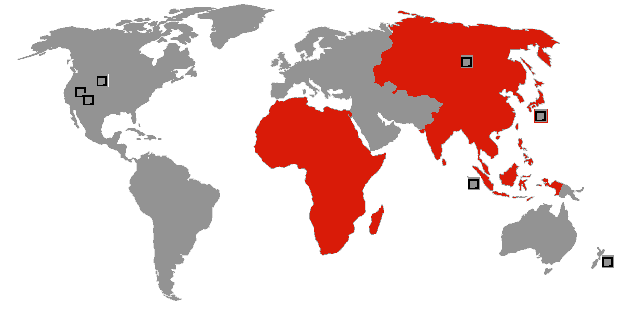
Long Valley, Calif., near the Nevada border

Long Valley Caldera at a Glance |
|
|---|---|
| The Caldera. Long Valley Caldera a 15- by 30-km oval-shaped depression located 20 km south of Mono Lake along the east side of the Sierra Nevada in east-central California. This area of eastern California has produced numerous volcanic eruptions over the past 3 million years, including the massive caldera-forming eruption 760,000 years ago. The most recent eruption occurred just 250 years ago in Mono Lake at the north end of Mono-Inyo Craters volcanic chain. | |
| Volcanic Unrest. In May of 1980, a strong earthquake swarm that included four magnitude 6 earthquakes struck the southern margin of Long Valley Caldera associated with a 25-cm, dome-shaped uplift of the caldera floor. These events marked the onset of the latest period of caldera unrest that continues to this day. This ongoing unrest includes recurring earthquake swarms and continued dome-shaped uplift of the central section of the caldera (the resurgent dome) accompanied by changes in thermal springs and gas emissions. | |
| USGS Monitoring. In 1982, the U.S. Geological Survey under the Volcano Hazards Program began an intensive effort to monitor and study geologic unrest in Long Valley caldera. The goal of this effort is to provide residents and civil authorities in the area reliable information on the nature of the potential hazards posed by this unrest and timely warning of an impending volcanic eruption, should it develop. Most, perhaps all, volcanic eruptions are preceded and accompanied by geophysical and geochemical changes in the volcanic system. Common precursory indicators of volcanic activity include increased seismicity, ground deformation, and variations in the nature and rate of gas emissions. | |
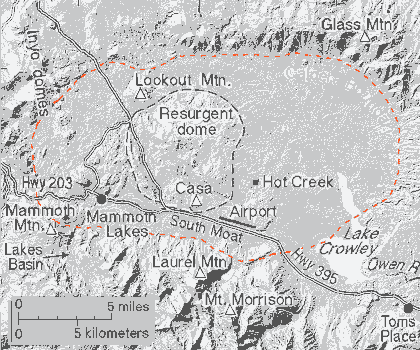
Text and Maps from USGS

Valle Grande, N.M., near Los Alamos

The one million-year-old Valles Caldera (15-mi diameter) is the centerpiece of the Jemez Volcanic Field in North Central New Mexico. The caldera was formed when the volcanic pile collapsed in response to a huge eruption of ash from the magma chamber.
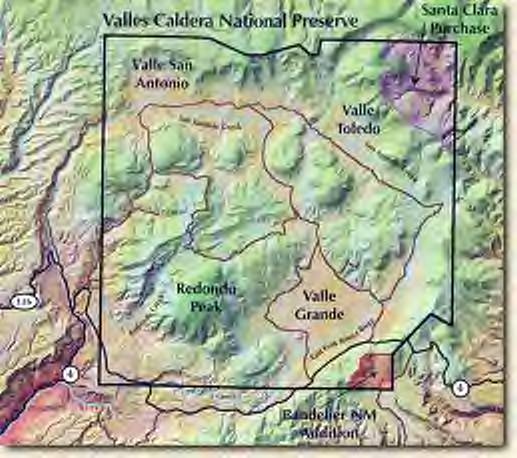
http://www.vallescalderacoalition.org
Lake Taupo, New Zealand
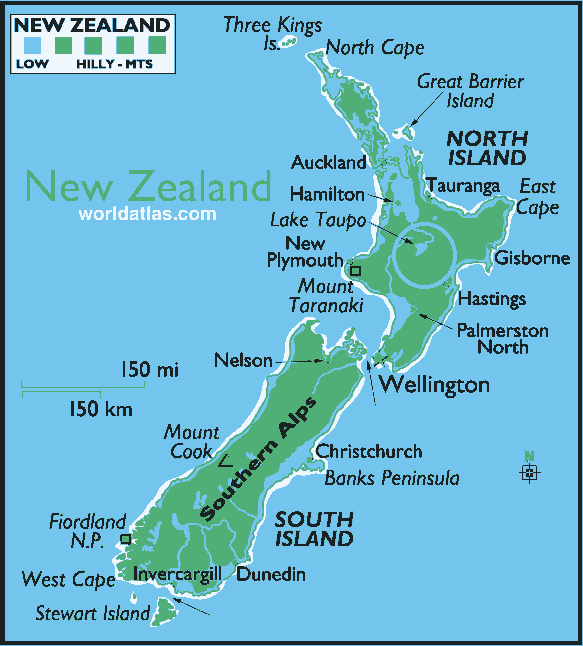
credit: http://worldatlas.com
Taupo’s
History
Taupo Volcano has been in existence for more than 65 000
years. In that time it has shown a random pattern of
exceptionally large events interspersed by smaller
eruptions. This is a pattern typical of all the major
rhyolite volcanoes of the central North Island and together
they have produced large eruptions about every 50,000 years.
At Taupo the Oruanui and the Taupo eruptions are part of
this larger pattern.
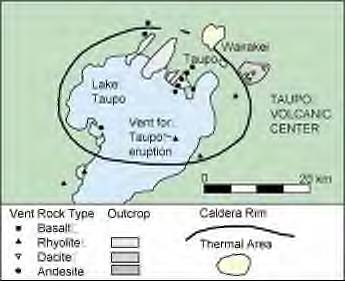
credit:
http://volcano.und.nodak.edu/vwdocs/volc_images/australia/new_zealand/taupo.html
Pre 65,000 years ago
All deposits at Taupo including a number of early lava domes
clearly post-date the exceptionally large Whakamaru
ignimbrite eruption dated at 330,000 years ago. About
150,000 years ago new activity formed a pumice-rich
ignimbrite found along the northern shores of the lake,
several basalt scoria cones and tuff rings about Acacia Bay
and Mt. Tauhara. Our knowledge of this time intervals is
very incomplete as few deposits of this age are exposed.
65,000 to 27,000 years ago
Between 65,000 years and 27,000 years ago there was a series
of at least five explosive eruptions, from vents now under
Lake Taupo. The older four eruptions produced layers of
coarse pumice. The youngest produced fine grey ash
suggesting the mixing of lake water with erupting magma.
The Oruanui eruption 26,500 years ago
The largest eruption from Taupo occurred 26,500 years ago
producing 300 km³ of ignimbrite, 500 km³ of pumice and ash
fall and a unknown volume of material inside the caldera.
The Oruanui eruption is thought to have formed the caldera
now filled by Lake Taupo, but this large eruption also shows
the influence of lake water in its fine grain size and
abundant evidence for heavy rain during the eruption. This
implies the existence of a large lake prior to the eruption.
The Oruanui ignimbrite is seen in many road cuttings about
Taupo, draped by the layers of younger tephra. Fine ash from
this eruption has been found throughout New Zealand and in
many offshore core samples.
Credit: VOLCANIC HAZARDS AT TAUPO VOLCANIC CENTRE By Paul Froggatt
Victoria Link Ltd & Research School of Earth Sciences, Victoria University of Wellington
http://www.gns.cri.nz/what/earthact/volcanoes/nzvolcanoes/taupoprint.htm
Aira, Japan
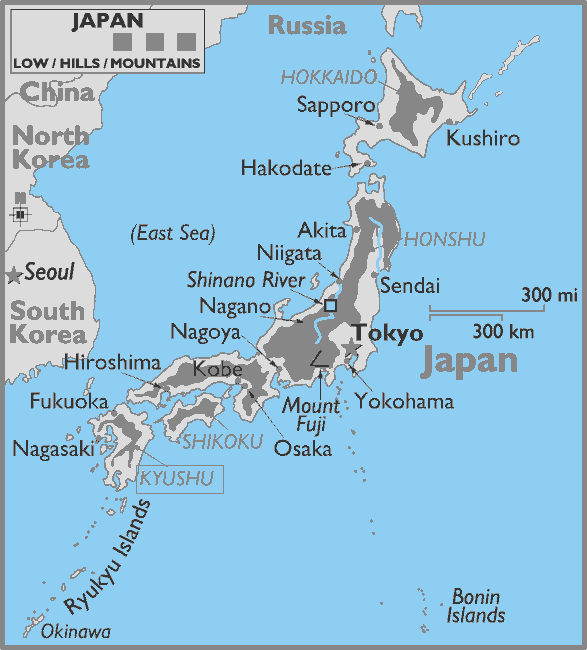
credit: http://worldatlas.com
Aira Caldera is a supervolcanic caldera in the south of the island of Kyushu, Japan. The caldera was created by a massive eruption, approximately 22000 years ago. The major city of Kagoshima, Kagoshima and the 13000 year old Sakurajima volcano lie within the caldera.
http://www.volcanoworld.org/vwdocs/vw_hyperexchange/sakura-jima.html
Lake Toba, Sumatra
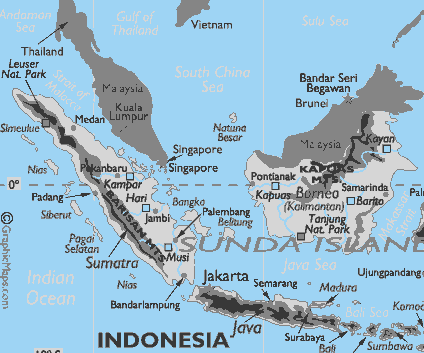
One of the largest known volcanic eruptions took place only 74,000 yrs ago, when over 2500 cubic kilometers of magma was ejected from Toba - a volcano-tectonic depression that is often referred to as Earth's largest Quaternary caldera. The caldera is 18 x 60 miles (30 by 100 km) and has a total relief of 5,100 feet (1700 m).
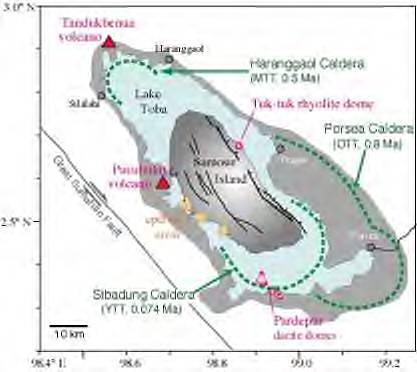
credit: http://www.rpi.edu/~warkd/toba/toba_geology.html
The caldera probably formed in stages. Large eruptions occurred 840,000, about 700,000, and 75,000 years ago. The eruption 75,000 years ago produced the Young Toba Tuff. The Young Toba Tuff was erupted from ring fractures that surround most or all of the present-day lake.
Siberian Traps, Russia
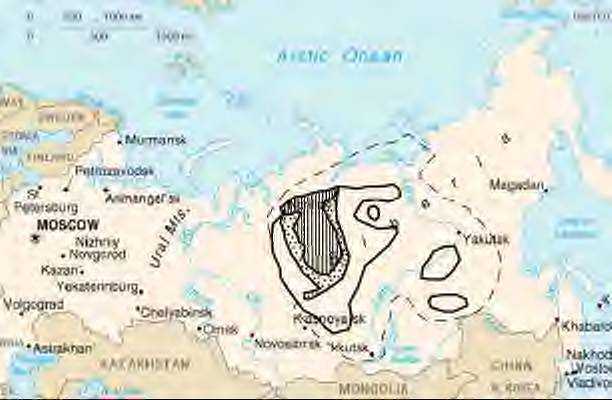
http://palaeo.gly.bris.ac.uk/Palaeofiles/Permian/SiberianTraps.html
The Siberian Traps form a large igneous province in Siberia. They were formed during the Permian-Triassic extinction event in what was one of the largest known volcanic event in the last 500 million years of the geological history of the Earth.
Super Volcano In Yellowstone National Park
Source: United States Geological Survey, University of Utah, The BBC

It is little known that lying underneath one of The United States largest and most picturesque National Parks - Yellowstone Park - is one of the largest "super volcanoes" in the world.
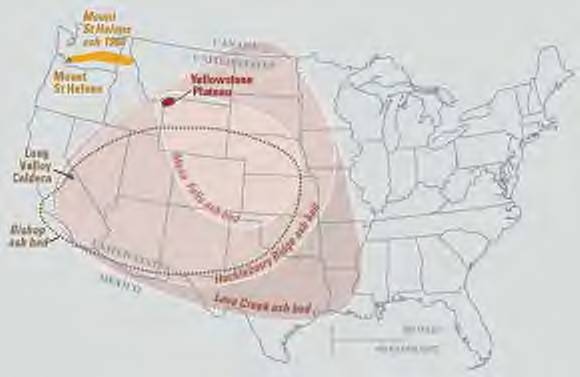
Eruptions of the Yellowstone volcanic system have included the two largest volcanic eruptions in North America in the past few million years; the third largest was at Long Valley in California and produced the Bishop ash bed. The biggest of the Yellowstone eruptions occurred 2.1 million years ago, depositing the Huckleberry Ridge ash bed. These eruptions left behind huge volcanic depressions called “calderas” and spread volcanic ash over large parts of North America (see map). If another large caldera-forming eruption were to occur at Yellowstone, its effects would be worldwide. Thick ash deposits would bury vast areas of the United States, and injection of huge volumes of volcanic gases into the atmosphere could drastically affect global climate. Fortunately, the Yellowstone volcanic system shows no signs that it is headed toward such an eruption in the near future. In fact, the probability of any such event occurring at Yellowstone within the next few thousand years is exceedingly low.
http://pubs.usgs.gov/fs/2005/3024
The term "supervolcano" has no specifically defined scientific meaning. It was used by the producers of The BBC TV show Horizion in 2000 to refer to volcanoes that have generated Earth's largest volcanic eruptions. As such, a supervolcano would be one that has produced an exceedingly large, catastrophic explosive eruption and a giant caldera.
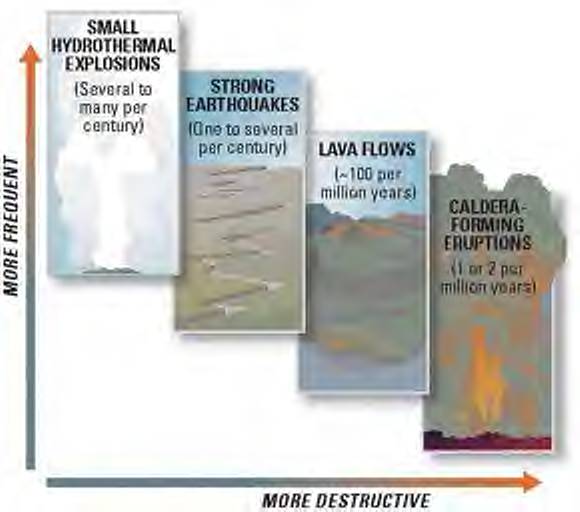
Scientists evaluate natural-hazard levels by combining their knowledge of the frequency and the severity of hazardous events. In the Yellowstone region, damaging hydrothermal explosions and earthquakes can occur several times a century. Lava flows and small volcanic eruptions occur only rarely—none in the past 70,000 years. Massive caldera-forming eruptions, though the most potentially devastating of Yellowstone’s hazards, are extremely rare—only three have occurred in the past several million years. U.S. Geological Survey, University of Utah, and National Park Service scientists with the Yellowstone Volcano Observatory (YVO) see no evidence that another such cataclysmic eruption will occur at Yellowstone in the foreseeable future. Recurrence intervals of these events are neither regular nor predictable.
Scientists have revealed that Yellowstone Park has been on a regular eruption cycle of 600,000 years. The last eruption was 640,000 years ago…so the next is overdue. The next eruption could be 2,500 times the size of the 1980 Mount St. Helens eruption. Volcanologists have been tracking the movement of magma under the park and have calculated that in parts of Yellowstone the ground has risen over seventy centimeters this century.
Around the world there are several other volcanic areas that can be considered "supervolcanoes"- Long Valley in eastern California, Toba in Indonesia, and Taupo in New Zealand. Other "supervolcanoes" would likely include the large caldera volcanoes of Japan, Indonesia, Alaska (e.g. Aniakchak, Emmons, Fisher).

Normal volcanoes are formed by a column of magma - molten rock - rising from deep within the Earth, erupting on the surface, and hardening in layers down the sides. This forms the familiar cone shaped mountain we associate with volcanoes.

Supervolcanoes, however, begin life when magma rises from the mantle to create a boiling reservoir in the Earth's crust. This chamber increases to an enormous size, building up colossal pressure until it finally erupts. The explosion would send ash, dust, and sulfur dioxide into the atmosphere, reflecting the sun's rays and creating a cold wave lasting several years. Crops in many areas would fail and many species of animals and plants would face extinction.
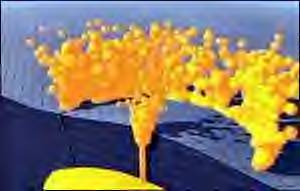
Volcanic activity began in the Yellowstone National Park region a little before about 2 million years ago. Molten rock (magma) rising from deep within the Earth produced three cataclysmic eruptions more powerful than any in the world's recorded history. The first caldera-forming eruption occurred about 2.1 million years ago. The eruptive blast removed so much magma from its subsurface storage reservoir that the ground above it collapsed into the magma chamber and left a gigantic depression in the ground- a hole larger than the state of Rhode Island. The huge crater, known as a caldera, measured as much as 80 kilometers long, 65 kilometers wide, and hundreds of meters deep, extending from outside of Yellowstone National Park into the central area of the Park.
The most recent caldera-forming eruption about 650,000 years ago produced a caldera 53 x 28 miles (85 x 45 kilometers) across in what is now Yellowstone National Park (Figure 2). During that eruption, ground-hugging flows of hot volcanic ash, pumice, and gases swept across an area of more than 3,000 square miles. When these enormous pyroclastic flows finally stopped, they solidified to form a layer of rock called the Lava Creek Tuff. Its volume was about 240 cubic miles (1,000 cubic kilometers), enough material to cover Wyoming with a layer 13 feet thick or the entire conterminous United States with a layer 5 inches thick. The Lava Creek Tuff has been exposed by erosion at Tuff Cliff, a popular Yellowstone attraction along the lower Gibbon River.
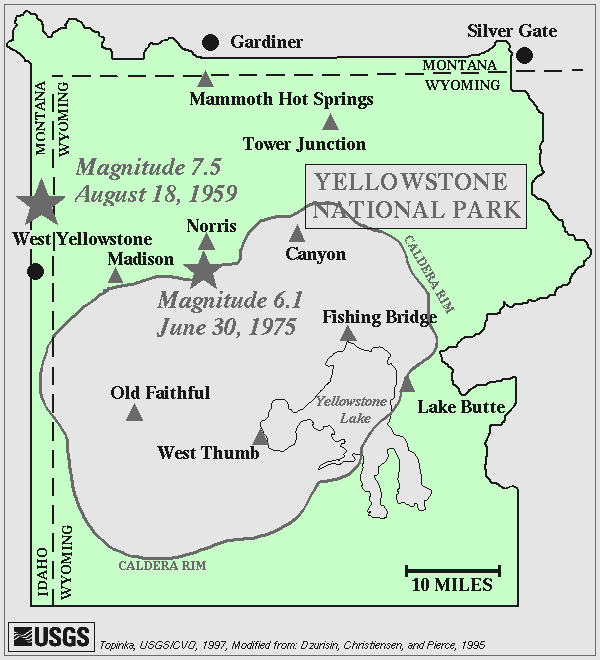
The eruption also shot a column of volcanic ash and gases high into Earth's stratosphere. This volcanic cloud circled the globe many times and affected Earth's climate by reducing the intensity of solar radiation reaching the lower atmosphere and surface. Fine volcanic ash that fell downwind from the eruption site blanketed much of North America. This ash layer is still preserved in deposits as far away as Iowa, where it is a few inches thick, and the Gulf of Mexico, where it is recognizable in drill cores from the sea floor. Lava flows have since buried and obscured most of the caldera, but the underlying processes responsible for Yellowstone's tremendous volcanic eruptions are still at work.
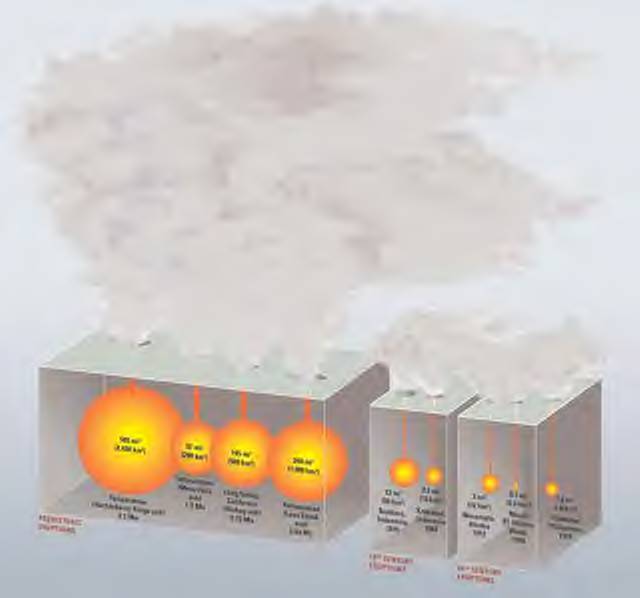
Explosive eruptions are best compared by recalculating the volume of erupted volcanic ash and pumice in terms of the original volume of molten rock (magma) released (shown in this diagram by orange spheres). On this basis, the 585 cubic miles (mi3) of magma that was erupted from Yellowstone 2.1 million years ago (Ma) was nearly 6,000 times greater than the volume released in the 1980 eruption of Mount St. Helens, Washington, which killed 57 people and caused damage exceeding $1 billion. Even the 1815 Tambora, Indonesia, eruption—the largest on Earth in the past two centuries—was more than five times smaller than the smallest of Yellowstone’s three great prehistoric eruptions at 1.3 Ma.
TINY CRYSTALS PREDICT A HUGE VOLCANO IN WESTERN U.S.
![]()
Press Release
MADISON - Reading the geochemical fine print found in tiny crystals of the minerals zircon and quartz, scientists are forming a new picture of the life history - and a geologic timetable - of a type of volcano in the western United States capable of dramatically altering climate sometime within the next 100,000 years.
With insight gained from new analytical techniques to study crystals of zircon and quartz, minerals that serve as veritable time capsules of geologic events, a group of scientists from the University of Wisconsin-Madison has proposed a new model for the origin of volcanism in young calderas.
These are volcanoes that occur over "hot spots" in the Earth and they erupt every few hundred thousand years in catastrophic explosions, sending hundreds to thousands of cubic kilometers of ash into the atmosphere and wreaking climatic havoc on a global scale.
In a series of papers, UW-Madison geologists Ilya N. Bindeman and John W. Valley present a life history of the hot spot volcanism that has occurred in the Yellowstone basin of the western United States over the past 2 million years. Their findings suggest a dying, but still potent cycle of volcanism, and a high probability of a future catastrophic eruption sometime within the next million years, and possibly within the next hundred thousand years.
Today's Yellowstone landscape represents the last in a sequence of calderas - the broad crater-like basins created when volcanoes explode and their characteristic cones collapse - that formed in regular progression over the past 2 million years. The near-clockwork timing of eruptions there - 2 million years ago, 1.3 million years ago and 600,000 years ago - suggests a pattern that may foreshadow an eruption of catastrophic proportions, said Bindeman and Valley.
Beneath Yellowstone and its spectacular landscape of hot springs and geysers is a hot spot, an upwelling plume of melted rock from the Earth's mantle. As the plume of hot, liquid rock rises in the Earth, it melts the Earth's crust and creates large magma chambers.
"These magmas usually erupt in a very catastrophic way," said Bindeman. "By comparison, the eruption of Mount St. Helens sent about two cubic kilometers of ash into the atmosphere. These catastrophic types of eruptions send thousands of cubic kilometers of ash skyward."
The hot spot deep beneath Yellowstone acts like a burner, said Bindeman. "It's a constant source of heat that acts on the upper crust and forms magma chambers that contain tens of thousands of cubic kilometers" of molten rock.
One of the massive plates that helps make up the crust of the Earth, the North American plate, is slowly moving over the hot spot, said Bindeman. "The plate has been moving across the heat source which makes it seem like the volcanoes are moving across the continent. Moreover, we have a progression of explosive eruptions which seem to have some periodicity."
Bindeman and Valley studied rocks that span the entire 2-million-year long eruptive sequence at Yellowstone with a special emphasis on lavas that erupted the last time one of the massive volcanoes popped off creating what geologists call the Yellowstone Caldera. Their conclusion is that the volcanic cycle is waning, but that there is still a very real potential of an eruption of massive proportions sometime in the near geologic future.
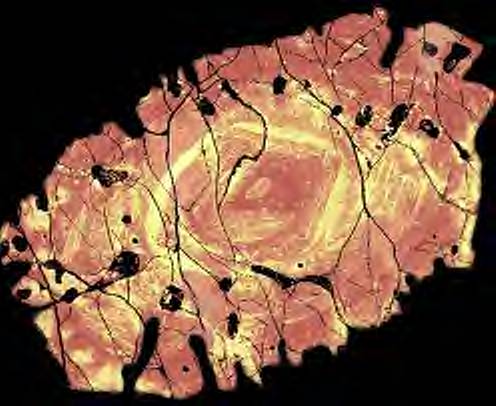
A cross section of a quartz
crystal obtained from rocks near Yellowstone. Crystals of
quartz and zircon harbor geochemical clues to past -- and
future -- volcanic eruptions in the Yellowstone caldera. In
the past, eruptions over this "hot spot" in the Earth have
been of a magnitude that would have severely altered Earth's
climate.
Image credit: Ilya Bindeman and John
Fournelle, remastered in Adobe Illustrator by Mary Diman
Such an eruption would disrupt global climate by injecting millions of tons of ash into the atmosphere. Some of the ash would remain in the atmosphere for years, reflect sunlight back into space and cool the planet, significantly affecting life. In addition, a blanket of ash over a meter thick would be deposited in nearby regions and effectively smother life there.
The most recent caldera is 600,000 years old and encompasses an area of more than 2,000 square kilometers. When it erupted, it blasted 1,000 cubic kilometers of volcanic rock into the atmosphere and it settled as ash over more than half of the United States.
After that last major eruption, volcanism in Yellowstone continued in a quieter fashion with another, much smaller eruption occurring 70,000 years ago.
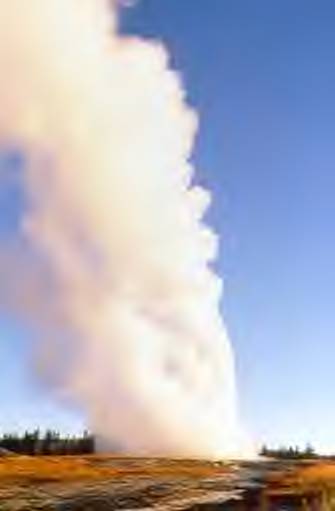
Old Faithful Geyser Yellowstone National Park
http://www.nps.gov/yell/oldfaithfulcam.htm
Today's spectacular geysers and hot springs at Yellowstone are the most visible part of the volcanic system there. They contain heated snow and rainwater which leave a geochemical record that provides insight into the region's geologic activity. Prior to the last catastrophic eruption at Yellowstone 600,000 years ago, an even more spectacular geothermal landscape existed there, said Bindeman.
"The unique thing about Yellowstone is that the volcanic rocks that erupted following the collapse of the big calderas contain up to 50 percent oxygen which was ultimately derived from rain waters," Bindeman said. "The zircon and quartz tell us that rocks near the surface were altered by heated snow and rainwater. These rocks were then remelted to become magmas."
This scenario changes the view of magmatism at Yellowstone and other calderas as representing new magma coming from deep in the Earth. On the contrary, Bindeman and Valley make a case for the total remelting and recycling of previously erupted surface rocks.
Their
findings have been published in a series of papers, the
first in the August 2000 edition of the journal Geology.
Another paper is to appear this month (July) in Earth and
Planetary Science Letters, and another is scheduled for
publication next month (August) in the Journal of Petrology.
Yellowstone Volcano Observatory

To strengthen the long-term monitoring of volcanic and earthquake unrest in the Yellowstone National Park region, the U.S. Geological Survey (USGS), Yellowstone National Park, and University of Utah have entered into an agreement to establish the Yellowstone Volcano Observatory (YVO).
Steam Explosions, Earthquakes, and Volcanic
Eruptions—What’s in Yellowstone’s Future?
U.S. Geological Survey
Fact Sheet 2005-3024
http://pubs.usgs.gov/fs/2005/3024




